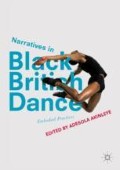Abstract
Golding presents a chapter as a biography and testimony to her experiences as a performer, practitioner and instructor in the creative aspects of African and Caribbean traditional dance forms. She discusses how as a first generation Black British Jamaican she has been strongly influenced by a sense of rediscovery of the ancient wisdom, symbolism, spirituality and history of African and Caribbean cultures—all of which has shaped her embodiment of dance, and has been consolidated through her undertaking of an academic study of Somatic Movement Education.
It is the desire to know one’s body, to live in the body, to obey it and its natural experiences, in full awareness, without the use of drugs. It is to have the courage to respect laws which are not always of logic, the irrational being one of the privileged languages of the body.
(Tierou, 1992, p. 12)
Access this chapter
Tax calculation will be finalised at checkout
Purchases are for personal use only
References
Ashby, M. (1996). Egyptian Yoga. The Philosophy of Enlightenment (p. 52). Miami, FL: Cruzian Mystic Books.
Cohen, B. B. (1993). Sensing Feeling and Action: The Experimental Anatomy of Body- Mind Centering. Northhampton, MA: Contact Editions.
Halprin, D. (2003). The Expressive Body in Life, Art and Therapy: Working with Movement (pp. 17–18). London: Jessica Kingsley Publishers.
Hametner, M. (1994). Buhne Leipzig Newspaper (p. 5).
Hanna, J. (1987). To Dance Is Human: A Theory of Nonverbal Communication (p. 3). Chicago: The University of Chicago Press.
Monteiro, N. M., & Wall, D. J. (2001, September). African Dance as Healing Modality Throughout the Diaspora: The Use of Ritual and Movement to Work Through Trauma. The Journal of Pan African Studies, 4(6), 237–248.
Primus, P. (1996). African Dance: An Artistic Historical and Philosophical Inquiry (Kariamu Welsh Asante, Ed., p. 7). Trenton, NJ: Africa World Press.
Tierou, A. (1992). Dooplé: The Eternal Law of African Dance (pp. 12–53). Philadelphia, PA, Harwood Academic Publishers.
Willis, W. B. (1998). The Adikra Dictionary: Visual Primer on the Language of a Adinkra (p. 189). Washington, DC: The Pyramid Complex Publishers.
Author information
Authors and Affiliations
Editor information
Editors and Affiliations
Rights and permissions
Copyright information
© 2018 The Author(s)
About this chapter
Cite this chapter
Golding, S. (2018). Moving Tu Balance: An African Holistic Dance as a Vehicle for Personal Development from a Black British Perspective. In: Akinleye, A. (eds) Narratives in Black British Dance. Palgrave Macmillan, Cham. https://doi.org/10.1007/978-3-319-70314-5_8
Download citation
DOI: https://doi.org/10.1007/978-3-319-70314-5_8
Published:
Publisher Name: Palgrave Macmillan, Cham
Print ISBN: 978-3-319-70313-8
Online ISBN: 978-3-319-70314-5
eBook Packages: Literature, Cultural and Media StudiesLiterature, Cultural and Media Studies (R0)

